
[Source: Alan Young]
Penruddock Station Gallery 1: c1910 - May 1966  The signal box and station building at Penruddock in 1910
Copyright photo from John Alsop collection  
1864 1: 2,500 OS map. The map is presumably misdated as the station opened in 1865. The otherwise single-track CK&P has a crossing loop at Penruddock with staggered platforms, the up (northern) platform being offset to the west of the down platform. The station building is on the up platform and its three rooms are indicated; the waiting shed on the down platform is also shown. The coal depot is named and its coal cells are indicated by bars across the siding. The coal depot’s weigh office (W.M. = weighing machine) and a crane are named. This map pre-dates the opening of a signal box (1874) at the west end of the up platform.
 1900 1: 2,500 OS map. Penruddock was the only station on the CK&P to have staggered platforms. On the up (northern) platform, which is offset to the west of the down platform, is the main building. The down platform is shown together with its waiting shelter. Sidings are provided on the up side, east of the platform; they appear to have been relocated a little to the north since the 1860s map, with the signal box (opened 1896 - replacing the 1874 box) between the sidings and the running lines. The coal depot with its weigh office (W.M. = weighing machine) and a crane are shown. To the west of the station, double track extends further west than in the 1860s.The stationmaster's house is shown a short distance north of the station on the approach road. The cattle dock is seen to the west of the coal depot with a separate entrance from the road for livestock and a pen on the dock. 1900 1: 2,500 OS map. Penruddock was the only station on the CK&P to have staggered platforms. On the up (northern) platform, which is offset to the west of the down platform, is the main building. The down platform is shown together with its waiting shelter. Sidings are provided on the up side, east of the platform; they appear to have been relocated a little to the north since the 1860s map, with the signal box (opened 1896 - replacing the 1874 box) between the sidings and the running lines. The coal depot with its weigh office (W.M. = weighing machine) and a crane are shown. To the west of the station, double track extends further west than in the 1860s.The stationmaster's house is shown a short distance north of the station on the approach road. The cattle dock is seen to the west of the coal depot with a separate entrance from the road for livestock and a pen on the dock.
 1925 1: 2,300 OS map. Penruddock station is shown with greater clarity on this map. The signal box (opened in 1896) has been added at the east end of the up platform located where the signalman can oversee passengers and barrows transferring between the ramps of the staggered platforms. The siding west of the down platform serves the horse dock. 
Looking west c1910 from the down platform towards the signal box, barrow crossing and the up platform with the station building. The identity of the railwayman and little girl is not known.
Copyright photo from John Alsop collection 
An unidentified ex-LNWR 'Cauliflower' 0-6-0 has just pulled out of Penruddock station heading west towards Workington. The loco still carries its LNWR-style wheel on the smokebox door. Many of the class later received the type as seen in the picture below. The train comprises LMS stock, of which the third vehicle is a later Stanier Period III type. The photo is undated but it appears to be late LMS - early BR days..
Photo from Jim Lake collection 
Penruddock station looking east towards Penrith from the up platform c1950. The staggered platforms are clearly seen. Goods facilities are on the up side east of the platform but there is also one short siding on the down side opposite the main station building which is seen here.
Photo from John Mann collection  Another ex-LNWR 'Cauliflower' 0-6-0 No. 58396 with, as would be expected for the period, ex-LMS stock. This loco was new in February 1900 as LNWR No. 38, eventually becoming BR No. 58396 in June 1948. She was among the very few survivors to actually carry a BR number and she was finally withdrawn in August 1953. During her brief BR career she was only in what is now Cumbria, allocated to Workington, from March 1948 until December 1951 so this photo will date from sometime
during that period Photo from Jim Lake collection 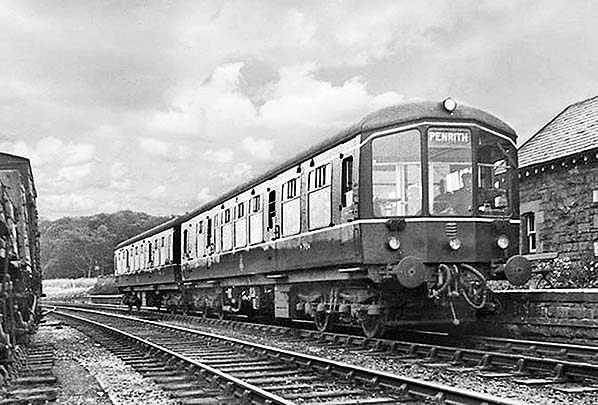
One of the original 'West Cumberland' batch of Derby Lightweight DMUs in the up platform at Penruddock station. It has already been modified to have a strengthening bar added behind the windscreens but still carries its original livery which was, until 1958, 'Locomotive Green' with lining as seen. Both cars carry the earlier lion-over-wheel (the 'Cycling Lion') BR logo; this was later applied only to power cars and would ultimately be replaced by the BR coaching stock roundel. The number of the Driving Motor car (that facing the camera) is only partially readable but by records it is M79014. This car had been intended to operate as part of a power twin but seems to have only ever operated in power/trailer combination, as seen here. New to service in January 1955, M79014 is recorded as having accrued a mileage of 51,010 by October of the same year. M79014 was withdrawn from service on Monday 6 May 1968, lingering at Upperby with other withdrawn cars for some time afterwards. Sixteen cars had been retained for possible sale to the group hoping to reopen the Borders line but, being withdrawn too early, M79014 was not among them. The last of the Cumbrian Derby Lightweights were withdrawn on 12 April 1969, being replaced mainly by what became Class 108.
Photo courtesy of Cumbrian Railway

The up platform at Penruddock is seen from a down train in July 1964. The totem nameplate and running-in nameboard are in BR(LM) livery.
Photo by Alan Young  Looking east along the up platform at Penruddock station in May 1966. The station is still staffed at this time with tickets available from the booking office (the forward-projecting section at the far end of the building). Although the main structure of the building is of stone the section either side of the door into the booking hall is of brick. Close to the signal box a barrow crossing provides access to the down platform. By this time the timber waiting room on this platform has been removed. Looking east along the up platform at Penruddock station in May 1966. The station is still staffed at this time with tickets available from the booking office (the forward-projecting section at the far end of the building). Although the main structure of the building is of stone the section either side of the door into the booking hall is of brick. Close to the signal box a barrow crossing provides access to the down platform. By this time the timber waiting room on this platform has been removed.Copyright photo by John Alsop
|

 Penruddock was unique among the CK&P stations in having staggered platforms, the down one being offset to the east. A barrow crossing connected the platforms, adjacent to the 1896 signal box. The station building stood on the up platform, of similar design to that at Troutbeck and some other minor stations on the route. It was constructed of stone and single storey under a pitched roof; however, at the eastern end the section containing the booking office stepped forward with a half-hipped gable facing east, presumably allowing the stationmaster to have a good view of the platforms – for the same reason that some railway companies provided a bay window for the office. The signal box, opened in 1896, also possessed a half-hipped roof. The down platform possessed only a small timber waiting shed. To provide accommodation for the stationmaster a nearby residence was purchased in July 1863, thought to be the house standing by the road on the up side approach.
Penruddock was unique among the CK&P stations in having staggered platforms, the down one being offset to the east. A barrow crossing connected the platforms, adjacent to the 1896 signal box. The station building stood on the up platform, of similar design to that at Troutbeck and some other minor stations on the route. It was constructed of stone and single storey under a pitched roof; however, at the eastern end the section containing the booking office stepped forward with a half-hipped gable facing east, presumably allowing the stationmaster to have a good view of the platforms – for the same reason that some railway companies provided a bay window for the office. The signal box, opened in 1896, also possessed a half-hipped roof. The down platform possessed only a small timber waiting shed. To provide accommodation for the stationmaster a nearby residence was purchased in July 1863, thought to be the house standing by the road on the up side approach.
 The 1904 Railway Clearing House Handbook shows that at this time that a 1-ton 10cwt crane was installed and that the station could handle the full range of goods, including furniture vans, carriages, portable engines, machines on wheels, livestock, horse boxes and prize cattle vans. Coal was also handled, but the Handbook did not indicate this.
The 1904 Railway Clearing House Handbook shows that at this time that a 1-ton 10cwt crane was installed and that the station could handle the full range of goods, including furniture vans, carriages, portable engines, machines on wheels, livestock, horse boxes and prize cattle vans. Coal was also handled, but the Handbook did not indicate this. 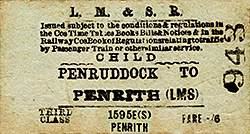 From 1 January 1923 at the ‘Grouping’ the line and station became part of the London, Midland & Scottish Railway (LMS). By this date the Penruddock stationmaster was John Clapham who had moved to the post in September 1921 from his role as parcels clerk at Keswick. He would be the last person to hold this post as the station came under the supervision of Troutbeck (date unknown) and then Blencow (in 1932). Mr Clapham continued living in Penruddock station house and it was later the home of other railwaymen.
From 1 January 1923 at the ‘Grouping’ the line and station became part of the London, Midland & Scottish Railway (LMS). By this date the Penruddock stationmaster was John Clapham who had moved to the post in September 1921 from his role as parcels clerk at Keswick. He would be the last person to hold this post as the station came under the supervision of Troutbeck (date unknown) and then Blencow (in 1932). Mr Clapham continued living in Penruddock station house and it was later the home of other railwaymen. 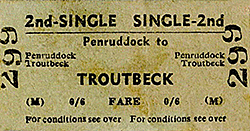 From 1 January 1948 Penruddock station was administered by British Railways (BR) London Midland Region (LM). The station, along with most of the others on the Workington – Penrith line, was fitted with BR(LM) maroon vitreous enamel nameboards and totem lamp tablets, probably in the late 1950s. Although the station had been gas-lit the lanterns in use by the late 1950s/early 1960s held oil lamps as the gas equipment had worn out.
From 1 January 1948 Penruddock station was administered by British Railways (BR) London Midland Region (LM). The station, along with most of the others on the Workington – Penrith line, was fitted with BR(LM) maroon vitreous enamel nameboards and totem lamp tablets, probably in the late 1950s. Although the station had been gas-lit the lanterns in use by the late 1950s/early 1960s held oil lamps as the gas equipment had worn out.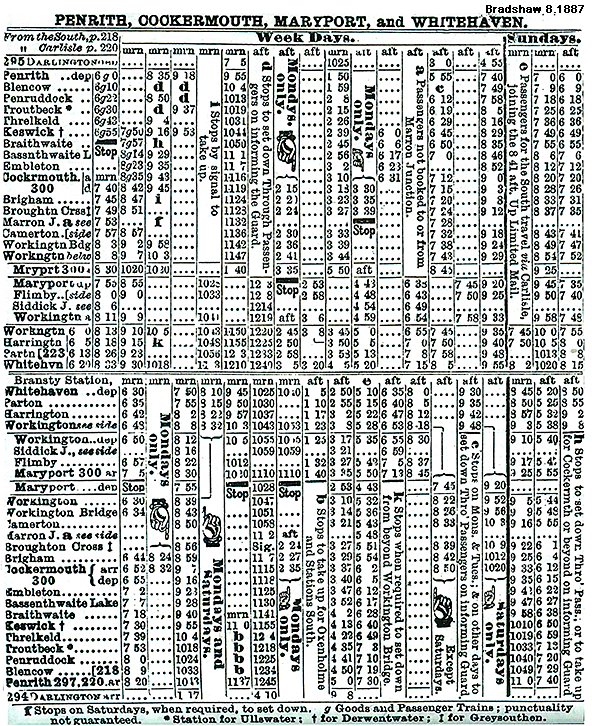
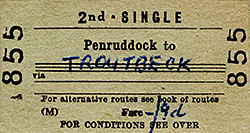 Whilst the Keswick to Workington section of the former CK&P closed to all traffic in April 1966 the Penrith-Keswick service continued for several years, but economies were made in operating the remaining branch. Goods had already ceased to be handled at Penruddock on 1 June 1964, and on 4 December 1967 the signal box closed when the operation of the branch went over to ‘one engine in steam’ – effectively one long siding. The down track through the station was removed and the down platform was taken out of use. The shelter on this platform was removed at or before the abandonment of this platform. Along with the other branch stations, Penruddock was unstaffed from 1 July 1968. In the mid 1960s an electric lamp was installed on each platform, replacing oil lighting.
Whilst the Keswick to Workington section of the former CK&P closed to all traffic in April 1966 the Penrith-Keswick service continued for several years, but economies were made in operating the remaining branch. Goods had already ceased to be handled at Penruddock on 1 June 1964, and on 4 December 1967 the signal box closed when the operation of the branch went over to ‘one engine in steam’ – effectively one long siding. The down track through the station was removed and the down platform was taken out of use. The shelter on this platform was removed at or before the abandonment of this platform. Along with the other branch stations, Penruddock was unstaffed from 1 July 1968. In the mid 1960s an electric lamp was installed on each platform, replacing oil lighting.  Penruddock up platform and main station building in March 1966, the staggered down platform is seen on the right.
Penruddock up platform and main station building in March 1966, the staggered down platform is seen on the right.

 Home Page
Home Page